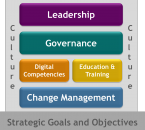[vc_row][vc_column width=”1/1″][vc_row_inner][vc_column_inner width=”1/4″ css=”.vc_custom_1431112543352{padding-top: 20px !important;}”][vc_column_text] [/vc_column_text][/vc_column_inner][vc_column_inner width=”3/4″ css=”.vc_custom_1424118256041{padding-top: 10px !important;}”][vc_column_text]Key digital transformation mistakes include not having an executive in charge,inadequate leadership buy-in and support,having decisions related to social and digital technologies made by people who lack sophistication, multiple fragmented, tactical approaches rather than a unified approach that is strategic and integrated, and executives who lack the proper perspective on revenues and expenses.[/vc_column_text][/vc_column_inner][/vc_row_inner][divider_line type=”divider_line”][vc_column_text]Digital transformation may seem like the latest business buzzword, but don’t let the perceived overuse (or misuse) of the term mislead you. We’re in at least the seventh decade of the Digital Era, and almost all organizations have been on a digital transformation journey for years. In many respects, and even in some of the most digitally sophisticated organizations, that journey has only just begun. As profound as the impact of computer technology has been since the late twentieth century, the kinds of changes organizations are now primed to experience are potentially even more powerful and pervasive.
[/vc_column_text][/vc_column_inner][vc_column_inner width=”3/4″ css=”.vc_custom_1424118256041{padding-top: 10px !important;}”][vc_column_text]Key digital transformation mistakes include not having an executive in charge,inadequate leadership buy-in and support,having decisions related to social and digital technologies made by people who lack sophistication, multiple fragmented, tactical approaches rather than a unified approach that is strategic and integrated, and executives who lack the proper perspective on revenues and expenses.[/vc_column_text][/vc_column_inner][/vc_row_inner][divider_line type=”divider_line”][vc_column_text]Digital transformation may seem like the latest business buzzword, but don’t let the perceived overuse (or misuse) of the term mislead you. We’re in at least the seventh decade of the Digital Era, and almost all organizations have been on a digital transformation journey for years. In many respects, and even in some of the most digitally sophisticated organizations, that journey has only just begun. As profound as the impact of computer technology has been since the late twentieth century, the kinds of changes organizations are now primed to experience are potentially even more powerful and pervasive.
Virtually every organization is destined to become a digital organization. It doesn’t matter how big or old the organization is, what sector or industry it operates in, whether it’s for-profit or non-profit, resource-rich or resource-poor. Digital transformation is inevitable. Ideally the process is well led, strategically-driven, evolutionary and methodical, as well as proactive, holistic, and integrated. The reality in most organizations, however, is that it is none of those things. Few have yet figured out how to break down the barriers to digital transformation, lay a roadmap for change, and/or build a digital transformation framework.
I get that it’s hard for leaders who are trying to do more with less to create and pursue a well-defined digital transformation strategy and plan for their organizations. But even without the luxury of a perfect master plan, transformation efforts can be better led, defined, and executed – and therefore more efficient and effective.
Here are some of the most common digital transformation mistakes I have encountered, along with recommendations for how to prevent and/or combat them. How many of these are true for your organization? Are steps being taken to address them? What other common digital transformation mistakes do you see?
Not having an executive in charge. Leadership is the most critical component in building a digital organization. Too often, however, the champions of digital transformation are not in the C-suite. Even if they’re senior leaders in the organization, these change agents don’t have the power or influence to make digital transformation a priority. And the executives who do have the power are consumed with managing the traditional business and operations – so focused on the past and the present that they fail to focus on or prepare for the future.
It’s true that digital transformation is a marathon not a sprint, a long-haul effort that requires a crawl-walk-run approach that will take years (and may never end). But the fact that transformation is not urgent should not leave executives with the false sense that there’s plenty of time and they don’t need to get started sooner than later. Time is of the essence.
Who should the executive in charge be? People who view digital transformation as primarily a customer-focused effort believe it should be led by the Chief Marketing Officer (CMO). Those who believe it is primarily a technology effort believe the leader should be the Chief Information Officer (CIO). Still others, recognizing the cross-functional focus transformation requires, call for the creation of a new role, the Chief Digital Officer (CDO). And still others believe the best way to give digital transformation the attention it deserves is to have the Chief Executive Officer (CEO) take the lead.
All of these C-suite executives are viable options, as are others. There is no single best answer. A CMO may make sense in a customer-driven enterprise, a CIO may be the logical choice for a government entity, and the President or Provost (effectively, the Chief Operating Officer) may be best for an academic institution.
The most important thing is to pick someone and give him/her clear responsibility, authority and accountability for digital transformation.
Inadequate leadership buy-in and support. Having an executive leader who serves as the champion and primary point person for digital transformation is necessary, but not sufficient. The entire executive team, as well as other key senior leaders, must understand what digital transformation means in the context of the organization’s operating environment and their own functional area. They must also share a commitment to converting the organization from one driven by increasingly-archaic Industrial Era principles and models to one that has adapted to Digital Era realities, embraced digital technology opportunities, and prepared for digital threats and risks.
When digital transformation is seen as an (unachievable) ideal, an adjunct to the core mission and operations, and/or something that can be delayed until it becomes critically necessary, the organization loses valuable time and progress. If it’s not a top priority, it probably shouldn’t even be on the organizational agenda.
There are multiple options for ensuring that leaders from multiple areas commit to digital transformation. Creating a steering committee, task force and/or center of excellence are advanced approaches to emphasizing the cross-functional aspects of digital transformation and breaking down silos. But those solutions shouldn’t absolve leaders from making personal commitments as well.
Digital transformation should be part of the agenda for every senior leadership meeting, strategy session, retreat, etc.
Having decisions related to social and digital technologies made by people who lack sophistication. It’s virtually impossible to make rational choices about social and digital technology solutions without a sophisticated understanding of how they can help pursue an opportunity or address a challenge, but people in organizations try to do it all that time. Many senior leaders and other professionals lack the knowledge, skills and abilities to determine whether traditional technology solutions are optimal, to evaluate the value of what vendors and service providers offer, and to discern the validity of what these providers promise. As a result, they may rely on outmoded approaches and ways of thinking and be unduly vulnerable to persuasive arguments from people with greater technical expertise.
Lacking digital sophistication themselves, leaders may delegate responsibility to people who have technical knowledge but don’t have the big-picture perspective and/or ability to put various options into proper perspective. These designated point people may also lack the executive management skills to ensure the pursuit of technology solutions is both efficient and effective.
It’s in an organization’s best interests to make the necessary investments to ensure their leaders are digitally literate and can lead digital transformation efforts. Having them participate in a digital transformation masterclass or boot camp (ideally, in cohorts) is one option. Providing formal digital literacy training and employing the services of digital coaches and mentors will also help them climb their learning curves faster and better.
Digital literacy must be viewed as a job requirement for leaders and senior professionals, and they must be provided with training and support to become more digitally sophisticated.
Multiple fragmented, tactical approaches rather than a unified approach that is strategic and integrated. Enterprise resource planning systems notwithstanding, the traditional approach to acquiring and implementing social and digital technologies has been siloed, with lines of business and major departments pursuing their own initiatives independently. With respect to digital transformation in particular, that kind of approach is increasingly inefficient and a potential waste of resources.
Unnecessary centralization and unwanted bureaucracy are not the solution, but there are new ways of approaching technology initiatives that balance independence and modularity with unity and integration (see this video on Government as a Platform for a sense of the concept). One of the necessary first steps is to assess the current state by conducting a digital inventory and audit, and then developing an optimization roadmap. Audits can be conducted for both external engagement and internal operations. They aren’t necessarily cheap and they can be a royal pain, but the short-term costs should be viewed as investment that can produce valuable returns both immediately and over the longer term.
Organizations should create and maintain a master list of social and digital technology initiatives and look for opportunities to optimize their efforts.
Lacking proper perspective on revenues and expenses. There are two dimensions to this problem. The first is focusing on increasing current revenue streams rather than focusing on new revenue development. Of course leaders should think about the value of increasing the revenue earned from existing products and services. But it is equally if not more important to think about how social and digital technologies can enable organizations to extend their traditional competencies into new products and services and markets.
The second dimension to this problem is emphasizing revenue over expenses. This issue seems especially acute in customer-oriented and sales-driven organizations, but it is evident in all of them. Though increasing gross income is obviously critical to an organization’s survival, preserving as much net income as possible is critical to its vitality and ability to thrive. There are real costs associated with poorly defined and implemented internal technology solutions. In addition to wasted resources from purchasing products and services that aren’t sufficiently adopted or properly leveraged, organizations with inadequate digital infrastructure suffer from operational inefficiency and ineffectiveness, suboptimized communication and collaboration, and inadequate innovation.
Addressing the preceding issues should help mitigate this one as well. With the right executive in charge, a general commitment from senior leaders who are digitally literate, and a master list of technology initiatives, organizations should be able to develop a clear sense of how technology can help both the top and bottom lines.
Investments in social and digital technology should be designed to both increase and expand revenues and decrease expenses.[/vc_column_text][/vc_column][/vc_row][vc_row][vc_column width=”1/1″][vc_column_text css=”.vc_custom_1411502073503{padding-bottom: 5px !important;}”]
Your Thoughts?
[/vc_column_text][vc_column_text]As always, I welcome your feedback. What questions has this piece raised for you? What would you add to, change, or delete from the assessments provided?
This essay originally appeared on Social Media Today as part of their Best Thinkers program.[/vc_column_text][divider_line type=”divider_line”][/vc_column][/vc_row]





